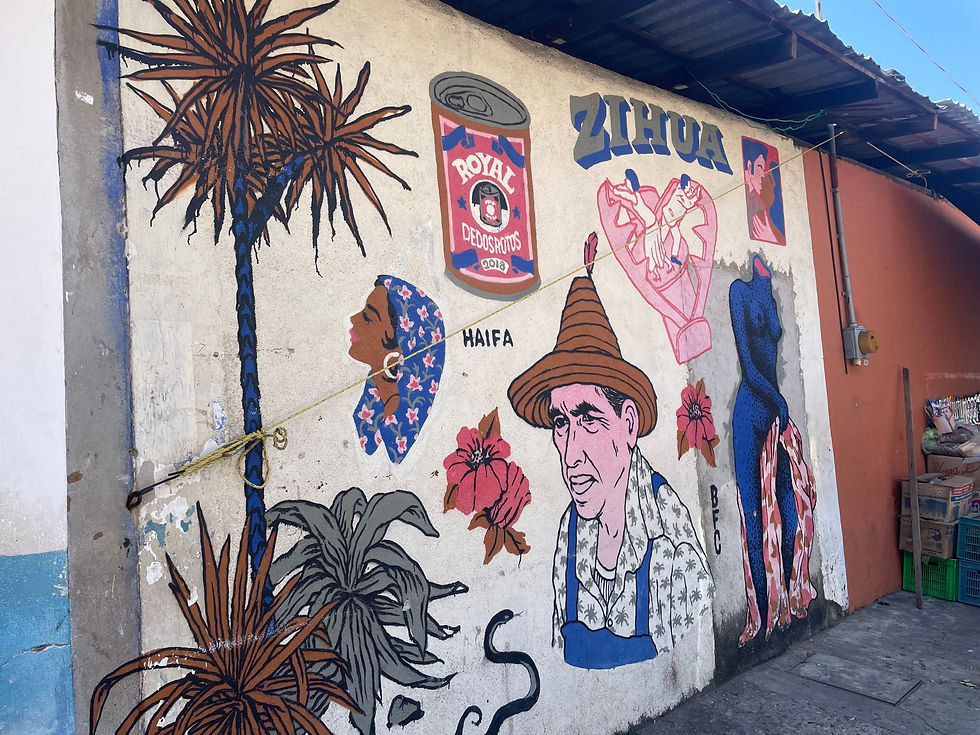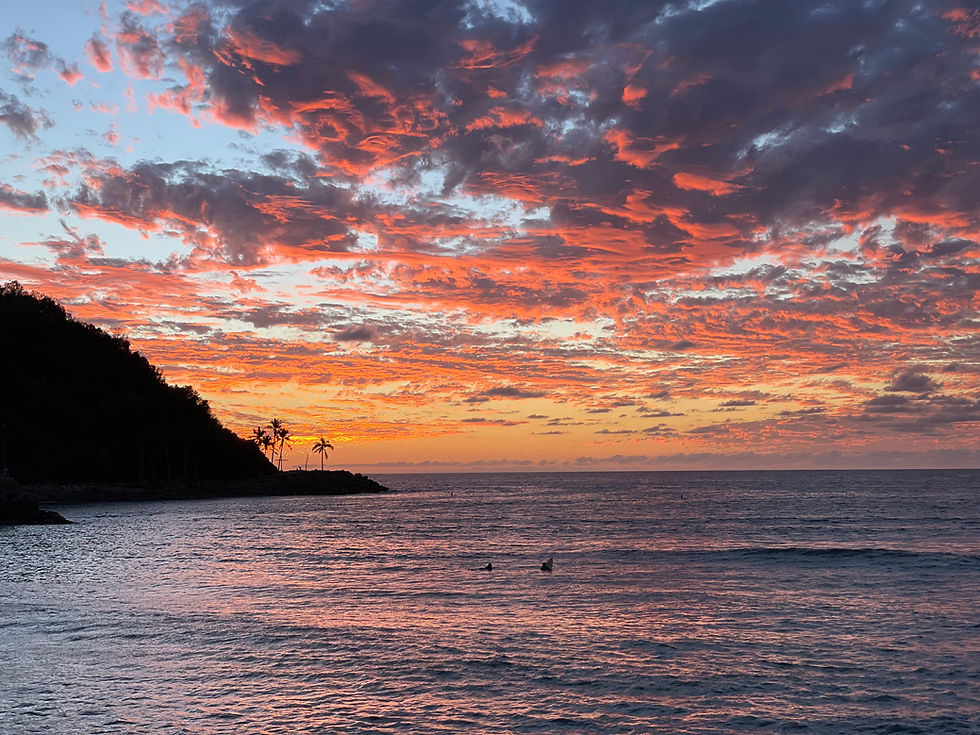Slow Travel by Sailboat: How We Choose Where to Go (and Why It’s So Hard Right Now)
- Jaclyn Jeffrey
- Aug 11
- 5 min read
Why We’re (Still) in El Salvador
We’ve been in El Salvador for over three months now. And we’re still here. Why? Because slow travel by sailboat often means waiting for the right time, and right now isn’t it. To the north, it’s hurricane season. To the south, it’s stormy season. And to top it off, the ocean swell is too big for us to safely cross the bar and head out into the Pacific Ocean.
For the last month, we’ve been trying to figure out our next move aboard SV Raicilla. And honestly? It’s not all about wind and weather this time. Here’s how we usually plan our cruising routes and why this one feels especially tough.

The Beauty (and Challenge) of Slow Travel by Sailboat
Sailing is, by nature, slow travel. Think jogging in a zigzag while everyone else takes the highway at fast speeds. A trip that would take a few hours by car can take us two days if we’re lucky. That slow pace shapes how we live. We stay longer in places, sometimes for days, sometimes for months.
It took us nearly two years to sail from Vancouver to El Salvador. We’re not breaking any speed records. That’s intentional. We get to linger, soak in each place, spend lazy days on the beach, or chat with locals and friends without feeling rushed.
But the tradeoff is this: every time we leave a place, we’re faced with the same big question: where to next?

How We Normally Choose Where to Sail Next
When we start a cruising season, we usually have a rough destination in mind. Two years ago, it was Mexico. Last summer, it was Puerto Peñasco for boat work. But that’s just one piece of the puzzle. There’s always a long list of ifs, ands, and maybes between point A and point B.
Here’s how we break it down:
Weather Seasons
Hurricane season shapes everything. In the eastern Pacific, that means staying either far north in the Sea of Cortez or heading far south, beyond the hurricane belt. Even then, storms don’t always follow the rules.
Costs
Some places are just more expensive. When we sailed the U.S. West Coast, we knew California would burn a hole in our wallet. So we headed to Ensenada early to wait out hurricane season because it was cheaper than San Diego. In Mexico, we stayed longer in affordable places and breezed through the pricier towns.
Dog
Sprocket goes where we go, but only if it’s comfortable for him. Long passages are tough on our old pup, and quarantine restrictions rule out some countries altogether. We’d love to visit the South Pacific, but not while he’s still aboard. For now, we plan shorter passages to dog-friendly destinations.
Once the big factors are accounted for, we move on to the rest.
Passage Conditions
One of us (me) is still a nervous sailor. Once the wind creeps over 15 knots, I start picturing broaches and pitch-poles. So we plan conservatively: low swell, light wind, and passages under three days. Thankfully our boat sails really well in the light winds, so we are able Look for light windows.
Instead of big offshore runs, we harbor-hop. That meant we got to visit coastal towns we’d otherwise skip, even if it involved crossing river bars or dealing with finicky weather in the Pacific Northwest. A lot of salty sailors will argue with us on this point, but we’re happy we hopped down the coast and enjoyed these small towns.

Pace
We don’t like feeling rushed. Our passage from Mexico to El Salvador this year felt like a race against the weather. Multiple two-day hops with barely time to catch our breath. By the time we arrived, we were exhausted. We’ve both agreed: whatever’s next, it’ll be at a slower pace.
Work
While we don’t work full-time, we still have to plan around it. Can we work from the boat? Is there a café or wifi spot ashore? If deadlines are looming, we prioritize work over sailing.
Why This Time Feels Harder
When we left Canada, the plan was clear: get to Mexico. Then it was haul-out in Puerto Peñasco. But this season? We launched the boat and just… drifted. We spent winter with friends in Barra de Navidad and Tenacatita, but didn’t look beyond that.
As friends sailed off to new countries or home, we were left staring at the chart, unsure what was next. We knew we didn’t want to spend another summer in Mexico’s desert heat—so we pointed south. That’s how we ended up here.
Now we’re back at the same crossroads: south to parts unknown or north to familiar waters. The South Pacific is off the table (until Sprocket goes to college), so our choice is: do we venture further or return to what we know?

The “Box Checker” Effect
This past season, we were surrounded by cruisers ticking off destinations like a to-do list: A, B, C, D—fast. That pressure snuck into our mindset. Were we doing enough? Seeing enough? Should we be sailing farther, faster, while we still can?
The “maybe we’re missing out” voice is loud. But so is the one saying: go where it feels right.
What Helps Us Decide (Eventually)
In the past, route planning felt simpler. Pick a goal, research the best weather windows, choose protected anchorages, and go.
Now, the stakes feel higher. We’re weighing entire regions—Panama, the Canal, the Caribbean—against the comforts and community we already know in Mexico. We’re comparing costs, passage lengths, dog access, internet, and livability. It’s a lot.
So we’re doing what any sensible cruiser would do: we made a voting jar.
Each day, we write down “North” or “South” on a slip of paper. At the end of the month, we’ll count the votes. Simple, but surprisingly helpful.
And when hurricane season ends, we’ll look for our weather window—and go.

Final Thoughts: You Don’t Always Have to Know What’s Next
We still don’t know where we’re going. And that’s okay.
Cruising is full of uncertainty. Sometimes, it’s a coin flip. Or a jar full of scribbled votes. The beauty of slow travel by sailboat is that we don’t have to rush. we don’t have to know. We just have to be ready when it’s time.
Tips for Other Cruisers Planning Their Next Move
Start early. We begin route planning ahead of time. Knowing historical data, watching wind trends and sea state. As the window gets closer, focus in on the smaller details.
Prioritize comfort. Swell and wave direction matter more than wind speed for us.
Use trusted tools. We rely on PredictWind, NOAA (where available), and Windy.
Look for local knowledge. Facebook groups, No Foreign Land, and WhatsApp chats are goldmines. Just filter with common sense.
Watch the CAPE index. Especially during storm season.
Trust your gut. If the weather window looks good but your instincts say no, don’t go.



So good to hear that you only venture to places that feel safe . Sending Happy Sailing Hugs 🤗🤗
Where ever the vote goes, I'm sure it's the best decision and you will be happy.🙂
Excellent update! Now I know what the bottle with the pens are for! Very unique but effective reasoning. ⛵😎
Love the picture you painted of Coopie and Ferguson. ❤️❤️
Lots of wonderful adventures and many more to come.⛵🌅😎❤️
Great Blog. How is El Salvador in Hurricane Season